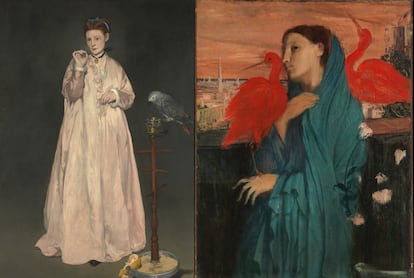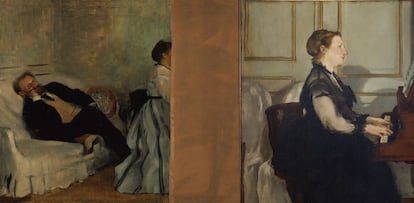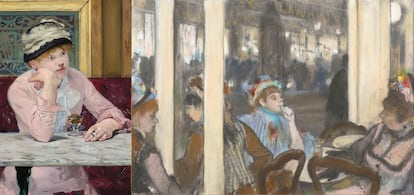Manet and Degas: A rivalry that altered art history
The Musée d’Orsay in Paris exhibits the tense relationship between the two 19th-century artists who helped forge the avant-garde that would lead to Impressionism


Manet and Degas met around 1860 at the Louvre while the 27-year-old Degas was copying Velázquez’s Portrait of the Infanta Margarita on a copper plate, with no prior drawing, as was the custom at the time. Manet, 29, was fascinated by Degas’ daring. It was the beginning of a brief but intense relationship, consisting of emulation and rivalry. The friendship ended when the pair quarreled over a painting Degas did of Manet and his wife almost 10 years later: M and Mme Edouard Manet, which deeply displeased Manet. Manet believed his wife to have been depicted as deformed due to the ineptitude of his friend, and decided to remove his wife from the canvas. Unable to bear the mutilation of his work, Degas took the painting home and returned a still life that Manet had given him, marking the beginning of the end between them.

That painting introduces the Manet/Degas exhibition that the Musée d’Orsay dedicates to the two painters, open in Paris until July 23, and moving to the Metropolitan Museum in New York for the fall. That the closeness between the two men flipped into enmity is largely speculation as hardly any letters or documents attesting to the reality of their relationship have been preserved. In their absence, the aim of the exhibition is to observe the breakdown of the friendship through the pictures they painted, which reflect the mounting tension between the two.
The exhibition brings together 200 works, many of them loans from European and American collections, reflecting how much Manet and Degas had in common. Both sons of the Parisian bourgeoisie, they were born during the 1830s, belonged to the same circles and frequented the same cafés, such as the café Guerbois, between Montmartre and Batignolles, also a favorite haunt of Monet, Renoir, Sisley and Zola. They were interested in the same themes and had the same need for recognition. They also helped forge the avant-garde that would lead to Impressionism, although Manet never wanted to be officially associated with the movement.

Keen to maintain their independence, neither of them had a classical training, although Degas briefly attended the École des Beaux-Arts in Paris. They learned by copying, transferring the legacy of the great masters they revered to the present time: for example, Manet emulated Titian for his painting Olympia and Chardin for The Soap Bubbles. They went to the same bistros and brothels, where they observed scenes of urban life and reflected “the transitory, the fleeting and the contingent” in their paintings.
But the two were also very different. Manet, who was a self-confessed post-romantic, admired the Spanish, while Degas followed Ingres and the Italians, and favored drawing and precise strokes. The former was a social and worldly animal, an expert in the art of seduction who sought applause, while the latter, proud of his misanthropy, was more discreet and reserved, and stopped any potential admirer from entering his workshop, which he considered a kind of laboratory . “He is more vain than intelligent,” Degas used to say of Manet.

Manet achieved fame a decade earlier: by 1860, he was already a central figure in the Parisian art scene and had exhibited at the sacrosanct Salon, while Degas remained an unknown. “The balance was redressed a decade later, by the role that the latter took in the organization of the Impressionist exhibitions from 1874,” notes the curator of the exhibition, Isolde Pludermacher, who insists that neither of the two was, as is often said, a cursed painter.
Even after they fought, the conversation between the pair continued. Halfway through the exhibition, Degas’ famous Steeplechase Scene (1866) appears, with its fallen jockey in the foreground. And next to it, the no less famous The Dead Toreador (1864-68) by Manet, on loan from the National Gallery in Washington, a second version of a larger composition depicting a bullfight. Faced with bad reviews, Manet decided to focus the painting on the figure of the matador, for which he garnered applause. His friend considered it plagiarism. “Degas accused Manet of copying his subjects, although today we realize that it was often the other way around,” says the other curator of the exhibition, Stéphane Guégan.

The best example might be Manet’s female silhouettes of nudes in the midst of country lunches, or his portraits of the painter Berthe Morisot, with whom he tried to conceal that he was in love. Manet’s blatant contemporary style contrasts with the more classical portraits of Degas in his early days. “When I was painting modern Paris, he was still portraying Semiramis,” Manet boasted. Degas followed in Manet’s footsteps, painting unhappy women, many of them prostitutes, whom he observed in melancholy interiors or crouching on the boulevards of Paris, as in The Absinthe Drinker (1876). A year later, Manet painted Plum Brandy, an almost identical composition set in a bar. The two paintings are almost identical, in the same way that The Seamstress by Manet seemed to mirror Degas’ In the Hat Shop, which Degas started earlier but finished five years later. But who copied whom?
The exhibition is a thrilling succession of comparative exercises, including their portraits of women with birds in the background, almost identical nudes in the bathtub, modern seascapes and beach prints, and jockeys with their faces blurred in the middle of a horse race. Theirs was a permanent competition, even if the exhibition proposes a kind of reconciliation in its final stretch. After Manet’s death in 1883, many of his works became part of Degas’ private collection. Degas bought the paintings from Manet’s widow and the art dealer Ambroise Vollard, and lived surrounded by them until his death three decades later.

The real happy ending is contained in the last room. Manet’s heirs had had the peculiar idea of cutting The Execution of Emperor Maximilian (1867-69) into several fragments. The Execution of Emperor Maximilian was a controversial painting about the execution of the ruler of Mexico that, in a new Hispanic tropism, seems to have been inspired by Goya’s The Third of May. It was never exhibited in France and was sold in pieces after the painter’s death. Degas set out to find the surviving pieces and bring them together in a single canvas, a posthumous tribute that indicates, perhaps definitively, the admiration he felt for his friend, despite all their mutual disagreements and irritations.
Sign up for our weekly newsletter to get more English-language news coverage from EL PAÍS USA Edition









































